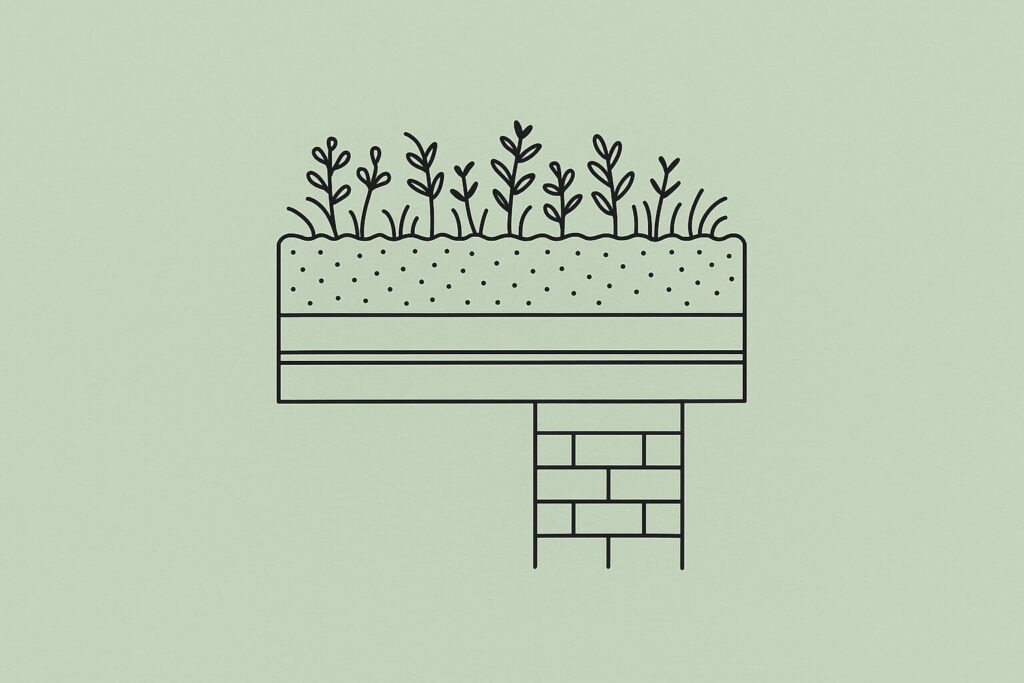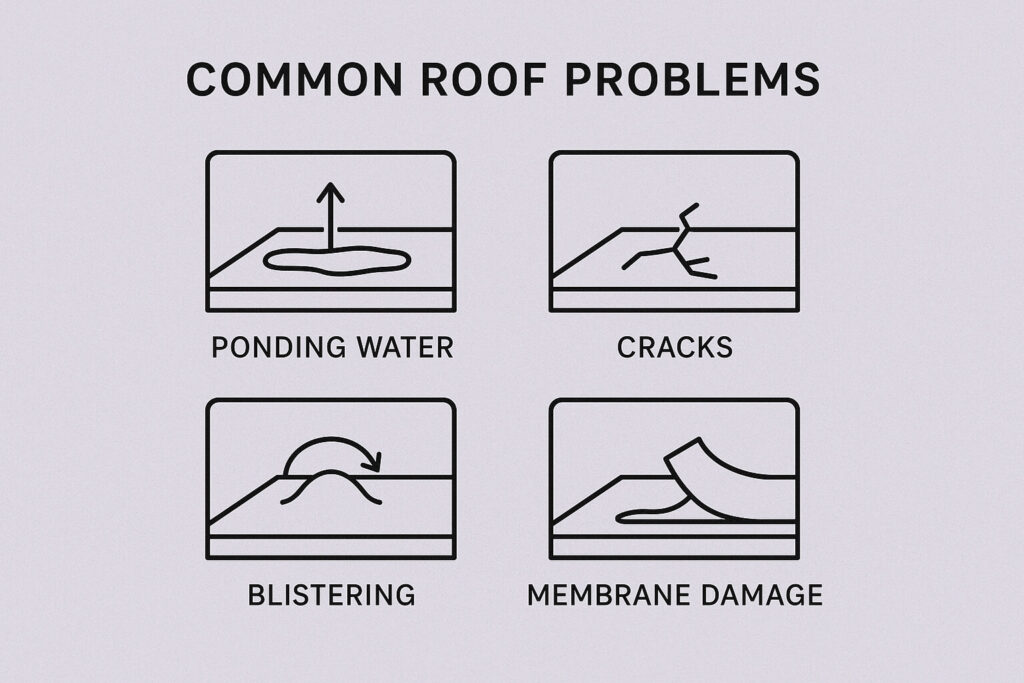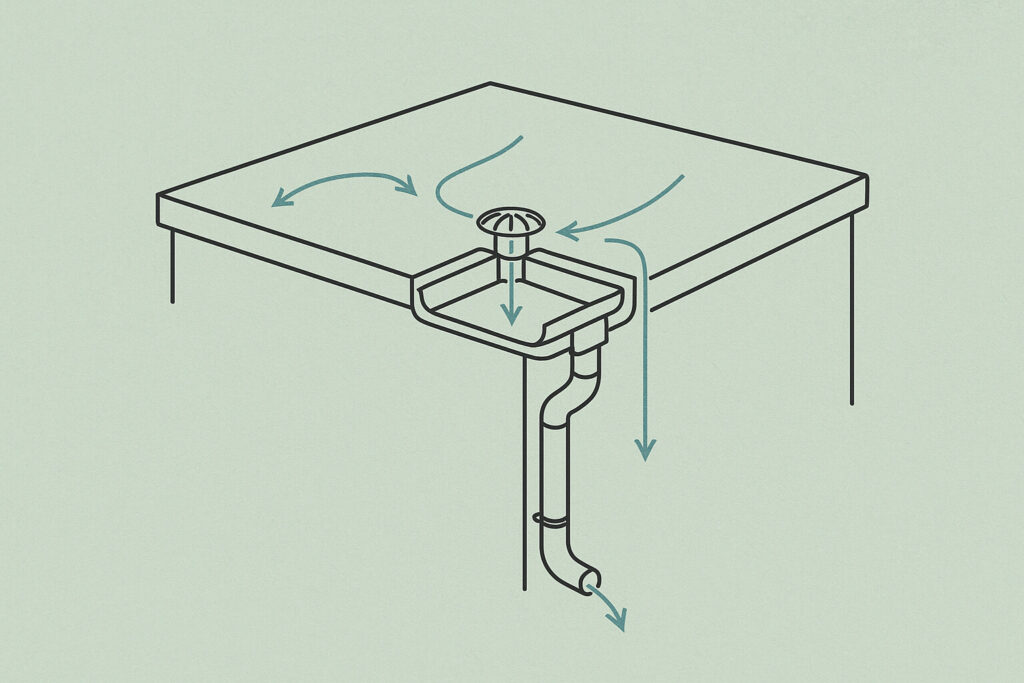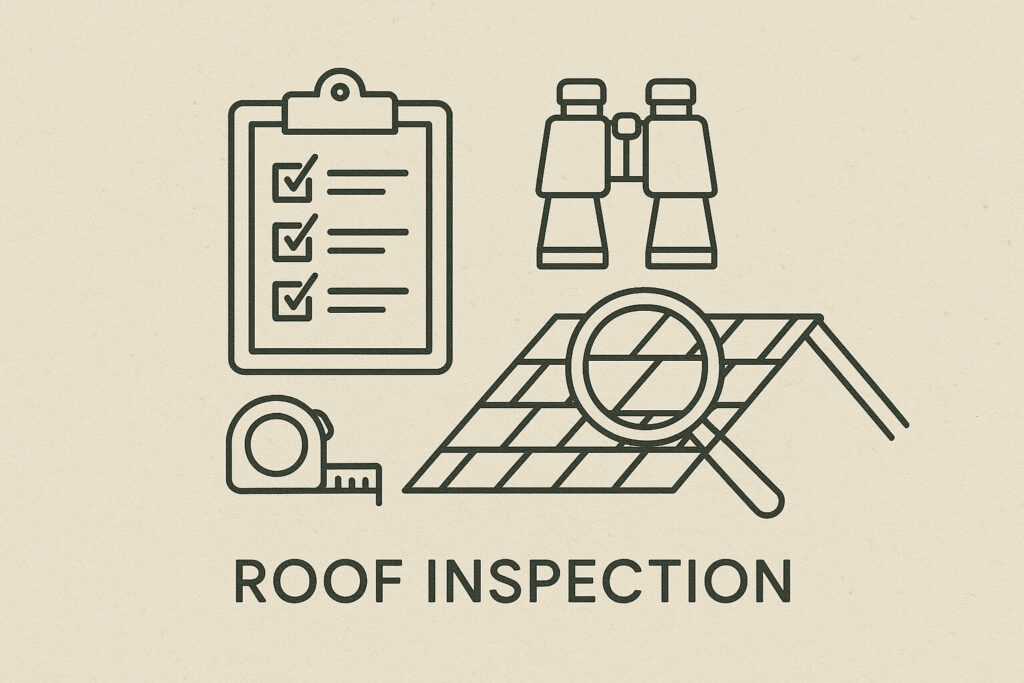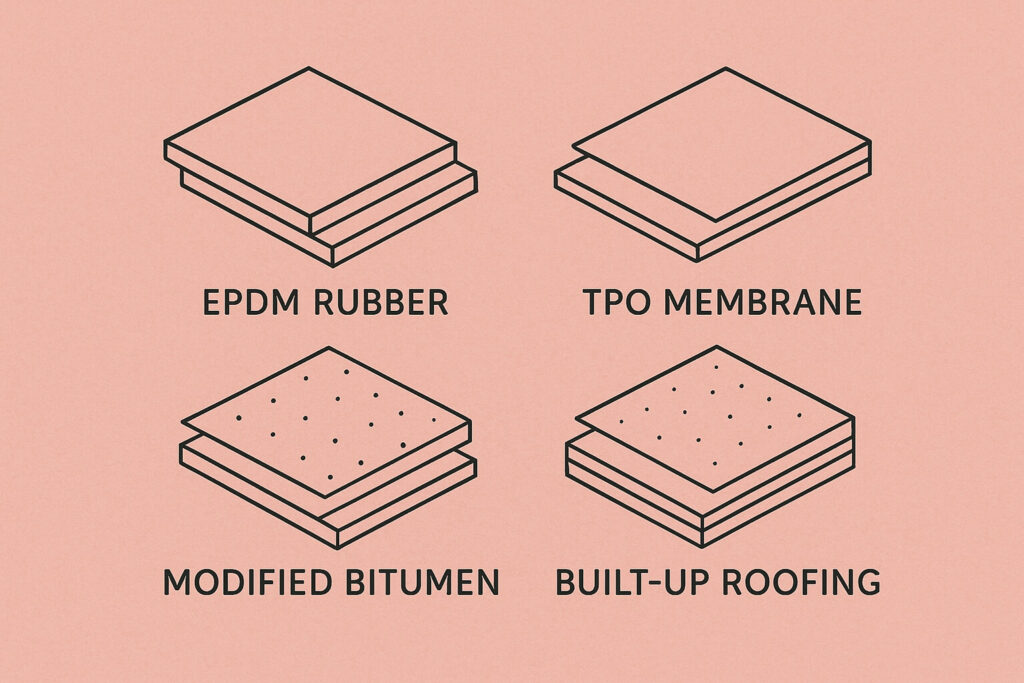The Benefits of Green Flat Roofs for Urban Sustainability
Green flat roofs are transforming flat roof spaces across Bristol, offering environmental, economic, and aesthetic benefits while addressing urban sustainability challenges. At Flat Roof Repair Bristol, we’ve seen growing interest in green roof installations—from residential extensions to commercial properties. This comprehensive guide explores the different green flat roof systems, their benefits for Bristol properties, and critical considerations for successful implementation on flat roof structures.
What is a Green Roof?
A green roof (also called a living roof or vegetated roof) is a roof system that incorporates vegetation over a waterproofing membrane, creating a living ecosystem on top of a building. On flat roofs, green roofs provide numerous advantages while requiring specific design considerations.
Basic components of a green roof system:
- Waterproofing membrane: EPDM or other high-performance flat roof membrane
- Root barrier: Prevents plant roots from penetrating the membrane
- Drainage layer: Manages excess water while retaining moisture for plants
- Filter fabric: Prevents soil from clogging the drainage system
- Growing medium: Lightweight soil substitute engineered for roof conditions
- Vegetation: Plants specifically selected for roof conditions
Types of Green Flat Roof Systems for Flat Roofs
Extensive Green Roofs
Characteristics:
- Shallow growing medium (50-150mm depth)
- Lightweight (60-150kg/m² when saturated)
- Low maintenance requirements
- Limited plant selection (typically sedums and grasses)
- Lower installation cost
Bristol recommendation: Ideal for most residential flat roofs and smaller commercial properties where structural capacity is limited.
Semi-Intensive Green Roofs
Characteristics:
- Moderate growing medium (150-250mm depth)
- Moderate weight (150-250kg/m² when saturated)
- Moderate maintenance (seasonal weeding, occasional watering)
- Broad plant selection (perennials, small shrubs)
- Moderate installation cost
Bristol recommendation: Suitable for properties with adequate structural support seeking more diverse planting options.
Intensive Green Roofs
Characteristics:
- Deep growing medium (250mm+ depth)
- Significant weight (250-500+ kg/m² when saturated)
- High maintenance requirements (regular watering, weeding, pruning)
- Wide plant selection (including small trees and lawns)
- Higher installation cost
Bristol recommendation: Best for commercial buildings with designed structural capacity or new constructions where weight can be accommodated.
Benefits of Green Roofs for Bristol Properties
Environmental Benefits
Green roofs address several environmental challenges facing Bristol:
- Stormwater management: Absorbs 50-90% of rainfall, reducing pressure on Bristol’s drainage systems during heavy rain events
- Urban heat island mitigation: Cools surrounding air through evapotranspiration, counteracting Bristol’s urban heat island effect
- Air quality improvement: Filters pollutants and particulates from the air
- Biodiversity enhancement: Creates habitats for insects, birds, and plants in urban environments
Economic Benefits
Green roofs deliver tangible financial advantages:
- Extended roof lifespan: Protects the waterproofing membrane from UV degradation and thermal fluctuations, potentially doubling roof life
- Energy savings: Provides additional insulation, reducing heating costs in winter and cooling costs in summer
- Property value increase: Enhances aesthetic appeal and marketability of properties
- Drainage fee reduction: Some local authorities offer reduced drainage charges for properties with sustainable drainage features
Our data shows that the extended roof lifespan alone often offsets the additional installation cost within 10-15 years—a significant consideration when evaluating long-term roof investment.
Aesthetic and Wellbeing Benefits
Green roofs enhance quality of life for Bristol residents:
- Visual appeal: Transforms unused roof space into attractive greenery
- Stress reduction: Access to green spaces improves mental wellbeing
- Noise reduction: Provides additional sound insulation from urban noise
- Usable space: Creates potential for rooftop gardens or relaxation areas
Bristol-Specific Green Roof Considerations
Climate Adaptation
Bristol’s unique coastal climate influences green roof design:
- Rainfall patterns: Design drainage to handle our 900mm+ annual rainfall while retaining sufficient moisture between rains
- Wind exposure: Secure planting medium in exposed areas like Kings Weston
- Temperature fluctuations: Select plants that tolerate Bristol’s variable conditions
- Coastal conditions: Use salt-tolerant species in areas like Sea Mills
Local Biodiversity Enhancement
Green roofs can support Bristol’s local ecology:
- Incorporate native plant species where appropriate
- Create habitat corridors across urban areas
- Include flowering plants to support pollinators
- Consider seasonal interest for year-round ecological value
Our projects often include species that benefit Bristol’s declining pollinator populations while thriving in roof conditions.
Planning and Regulatory Considerations
Bristol City Council has specific guidelines for green roofs:
- Check requirements for properties in conservation areas
- Verify weight capacity with a structural engineer
- Ensure proper drainage design meets local regulations
- Consider visibility from surrounding properties
We work closely with Bristol planning authorities to ensure compliance while maximising green roof benefits.
Technical Requirements for Successful Green Roofs
Structural Assessment
Before installation, verify your roof can support the additional weight:
- Consult a structural engineer for load calculations
- Consider both dead load (permanent weight) and live load (temporary weight)
- Account for saturated weight (growing medium holds significant water)
- Verify structural integrity of the existing roof
Many older Bristol properties require structural reinforcement before green roof installation.
Waterproofing System Requirements
The waterproofing membrane is critical for green roof success:
- Use high-quality, root-resistant membranes (EPDM is ideal)
- Ensure proper detailing at all penetrations and edges
- Install root barrier above the waterproofing membrane
- Verify manufacturer’s warranty covers green roof applications
At Flat Roof Repair Bristol, we specialise in installing green roof-compatible waterproofing systems that address the common flat roof problems that could compromise your green roof investment.
Drainage System Design
Proper drainage is essential for both plant health and roof protection:
- Maintain minimum 1:80 slope for positive drainage
- Install adequate number of drains for Bristol’s rainfall intensity
- Use drainage mats designed for green roof applications
- Include overflow pathways for extreme weather events
Our drainage designs incorporate lessons learned from maintaining flat roof drainage systems across Bristol.
Plant Selection for Bristol Flat Roofs
Choosing the right plants ensures long-term success:
Recommended Plant Types
For Bristol’s climate, these plants perform well on green roofs:
- Sedums: Drought-tolerant, low-growing, diverse colours
- Herbaceous perennials: Thrive with moderate maintenance
- Native grasses: Adapted to local conditions, support wildlife
- Wildflower mixes: Enhance biodiversity, seasonal interest
Planting Design Considerations
Create a successful planting scheme by considering:
- Microclimates: South-facing roofs receive more sun and wind exposure
- Zoning: Place drought-tolerant plants in high-exposure areas
- Succession planting: Ensure year-round visual interest
- Local adaptation: Prioritise species proven in Bristol’s climate
Maintenance Requirements for Bristol Green Roofs
Green roofs require ongoing care to thrive:
First Year Establishment
During the critical establishment phase:
- Water regularly during dry periods (first 6-12 months)
- Weed invasive species that may establish
- Monitor plant establishment and fill gaps as needed
- Check drainage systems after heavy rainfall
Ongoing Maintenance
Once established, maintenance requirements vary by system type:
- Extensive systems: 2-4 visits per year for weeding and inspection
- Semi-intensive systems: Monthly visits during growing season
- Intensive systems: Weekly maintenance similar to ground-level gardens
Bristol-specific tip: Schedule extra inspections after periods of intense rainfall to check for erosion or drainage issues.
Cost Analysis: Green Roofs vs. Traditional Flat Roofs
Understanding the financial implications is essential:
| Cost Factor | Traditional Flat Roof | Green Roof (Extensive) | Green Roof (Intensive) |
|---|---|---|---|
| Installation cost (per m²) | £45-£70 | £80-£120 | £150-£250 |
| Maintenance (annual per m²) | £1-£3 | £2-£5 | £5-£15 |
| Expected lifespan | 20-30 years | 30-40+ years | 30-40+ years |
| Energy savings (annual) | None | 5-10% | 8-15% |
Return on investment: While green roofs have higher initial costs, the extended roof lifespan, energy savings, and potential drainage fee reductions often make them cost-competitive over 15-20 years—particularly when considering the long-term value of quality roof construction.
Green Roof Case Studies in Bristol
Residential Extension in Clifton
Project: 12m² extensive green roof on kitchen extension
Challenges: Limited structural capacity, heritage property constraints
Solution: Lightweight system with sedum matting and minimal growing medium
Results: Blended with existing architecture, extended roof life, created private green space
Commercial Property in Temple Meads
Project: 200m² semi-intensive green roof on office building
Challenges: Managing stormwater runoff, creating staff amenity space
Solution: Diverse planting scheme with accessible pathways
Results: Reduced drainage fees, improved staff wellbeing, enhanced building aesthetics
Getting Started with Your Bristol Green Roof
Follow these steps to implement a successful green roof:
- Assess structural capacity with a qualified engineer
- Determine your goals (aesthetic, environmental, functional)
- Select appropriate green roof type for your needs and budget
- Choose plants suited to Bristol’s climate and your roof’s exposure
- Ensure proper waterproofing and drainage design
- Develop a realistic maintenance plan
At Flat Roof Repair Bristol, we specialise in green roof installations that combine environmental benefits with reliable waterproofing performance. Our expertise ensures your green roof not only looks beautiful but also protects your property for decades—addressing both ecological concerns and practical roofing needs. When combined with high-quality EPDM membranes, green roofs deliver exceptional longevity and performance in Bristol’s coastal climate.
